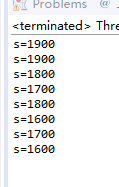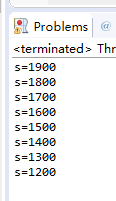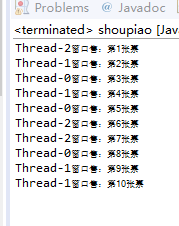201871010107-公海瑜《面向对象程序设计(java)》第十七周学习总结
201871010107-公海瑜《面向对象程序设计(java)》第十七周学习总结
| 项目 | 内容 |
| 这个作业属于哪个课程 | https://www.cnblogs.com/nwnu-daizh/ |
| 这个作业的要求在哪里 | https://www.cnblogs.com/nwnu-daizh/p/12073034.html |
| 作业学习目标 |
(1) 理解和掌握线程的优先级属性及调度方法; (2) 掌握线程同步的概念及实现技术; (3) Java线程综合编程练习 |
第一部分:总结线程同步技术
1.Java通过多线程的并发运行提高系统资源利用率,改善系统性能。
2.假设有两个或两个以上的线程共享某个对象,每个线程都调用了改变该对象类状态的方法,就会引起的不确定性。
3.多线程并发执行中的问题
◆多个线程相对执行的顺序是不确定的。
◆线程执行顺序的不确定性会产生执行结果的不确定性。
◆在多线程对共享数据操作时常常会产生这种不确定性。
4.多线程并发运行不确定性问题解决方案:引入线程同步机制。
当多个线程访问同一个数据时,容易出现线程安全问题,需要某种方式来确保资源在某一时刻只被一个线程使用。需要让线程同步,保证数据安全。
线程同步的实现方案:同步代码块和同步方法,均需要使用synchronized关键字
线程同步的好处:解决了线程安全问题
线程同步的缺点:性能下降,可能会带来死锁
5.(1)锁对象与条件对象
用ReentrantLock保护代码块的基本结构如下:
myLock.lock();
try { critical section }
finally{
myLock.unlock();
}
(2)synchronized关键字
synchronized关键字作用:
➢ 某个类内方法用synchronized 修饰后,该方法被称为同步方法;
➢ 只要某个线程正在访问同步方法,其他线程欲要访问同步方法就被阻塞,直至线程从同步方法返回前唤醒被阻塞线程,其他线程方可能进入同步方法。
6.Java中每个对象都有一个内置锁。
当程序运行到非静态的synchronized同步方法上时,自动获得与正在执行代码类的当前实例(this实例)有关的锁。获得一个对象的锁也称为获取锁、锁定对象、在对象上锁定或在对象上同步。
当程序运行到synchronized同步方法或代码块时才该对象锁才起作用。
一个对象只有一个锁。所以,如果一个线程获得该锁,就没有其他线程可以获得锁,直到第一个线程释放(或返回)锁。这也意味着任何其他线程都不能进入该对象上的synchronized方法或代码块,直到该锁被释放。
释放锁是指持锁线程退出了synchronized同步方法或代码块。
关于锁和同步,有一下几个要点:
1)只能同步方法,而不能同步变量和类;
2)每个对象只有一个锁;当提到同步时,应该清楚在什么上同步?也就是说,在哪个对象上同步?
3)不必同步类中所有的方法,类可以同时拥有同步和非同步方法。
4)如果两个线程要执行一个类中的synchronized方法,并且两个线程使用相同的实例来调用方法,那么一次只能有一个线程能够执行方法,另一个需要等待,直到锁被释放。也就是说:如果一个线程在对象上获得一个锁,就没有任何其他线程可以进入(该对象的)类中的任何一个同步方法。
5)如果线程拥有同步和非同步方法,则非同步方法可以被多个线程自由访问而不受锁的限制。
6)线程睡眠时,它所持的任何锁都不会释放。
7)线程可以获得多个锁。比如,在一个对象的同步方法里面调用另外一个对象的同步方法,则获取了两个对象的同步锁。
8)同步损害并发性,应该尽可能缩小同步范围。同步不但可以同步整个方法,还可以同步方法中一部分代码块。
9)在使用同步代码块时候,应该指定在哪个对象上同步,也就是说要获取哪个对象的锁。例如:
public int fix(int y) {
synchronized (this) {
x = x - y;
}
return x;
}
当然,同步方法也可以改写为非同步方法,但功能完全一样的,例如:
public synchronized int getX() {
return x++;
}
与
public int getX() {
synchronized (this) {
return x;
}
}
效果是完全一样的。
第二部分:实验部分
实验1:测试程序并进行代码注释。
测试程序1:
l 在Elipse环境下调试教材651页程序14-7,结合程序运行结果理解程序;
l 掌握利用锁对象和条件对象实现的多线程同步技术。
程序代码:
package synch; import java.util.*; import java.util.concurrent.locks.*; /** * A bank with a number of bank accounts that uses locks for serializing access. * @version 1.30 2004-08-01 * @author Cay Horstmann */ public class Bank { private final double[] accounts; //银行运转的基本数据 private Lock bankLock; //锁对象 private Condition sufficientFunds; /** * Constructs the bank. * @param n the number of accounts * @param initialBalance the initial balance for each account */ public Bank(int n, double initialBalance) { accounts = new double[n]; Arrays.fill(accounts, initialBalance); bankLock = new ReentrantLock(); sufficientFunds = bankLock.newCondition(); } /** * Transfers money from one account to another. * @param from the account to transfer from * @param to the account to transfer to * @param amount the amount to transfer */ public void transfer(int from, int to, double amount) throws InterruptedException { bankLock.lock(); try { //锁对象的引用条件对象 while (accounts[from] < amount) sufficientFunds.await(); System.out.print(Thread.currentThread()); //打印出线程号 accounts[from] -= amount; System.out.printf(" %10.2f from %d to %d", amount, from, to); accounts[to] += amount; System.out.printf(" Total Balance: %10.2f%n", getTotalBalance()); sufficientFunds.signalAll(); } finally { bankLock.unlock(); } } /** * Gets the sum of all account balances. * @return the total balance */ public double getTotalBalance() { bankLock.lock(); //加锁 try { double sum = 0; for (double a : accounts) sum += a; return sum; } finally { bankLock.unlock(); //解锁 } } /** * Gets the number of accounts in the bank. * @return the number of accounts */ public int size() { return accounts.length; } }
package synch; /** * This program shows how multiple threads can safely access a data structure. * @version 1.31 2015-06-21 * @author Cay Horstmann */ public class SynchBankTest { public static final int NACCOUNTS = 100; public static final double INITIAL_BALANCE = 1000; public static final double MAX_AMOUNT = 1000; public static final int DELAY = 10; public static void main(String[] args) { Bank bank = new Bank(NACCOUNTS, INITIAL_BALANCE); for (int i = 0; i < NACCOUNTS; i++) { int fromAccount = i; Runnable r = () -> { try { while (true) { int toAccount = (int) (bank.size() * Math.random()); double amount = MAX_AMOUNT * Math.random(); bank.transfer(fromAccount, toAccount, amount); Thread.sleep((int) (DELAY * Math.random())); } } catch (InterruptedException e) { } }; Thread t = new Thread(r); t.start(); } } }
运行结果:

测试程序2:
l 在Elipse环境下调试教材655页程序14-8,结合程序运行结果理解程序;
l 掌握synchronized在多线程同步中的应用。
程序代码:
package synch2; import java.util.*; /** * 具有多个使用同步原语的银行账户的银行。 * @version 1.30 2004-08-01 * @author Cay Horstmann */ public class Bank { private final double[] accounts; /** * Constructs the bank. * @param n the number of accounts * @param initialBalance the initial balance for each account */ public Bank(int n, double initialBalance) { accounts = new double[n]; Arrays.fill(accounts, initialBalance); } /** * 把钱从一个账户转到另一个账户。 * @param from the account to transfer from * @param to the account to transfer to * @param amount the amount to transfer */ public synchronized void transfer(int from, int to, double amount) throws InterruptedException { while (accounts[from] < amount) wait(); //导致线程进入等待状态直到它被通知。该方法只能在一个同步方法中调用。 System.out.print(Thread.currentThread()); //打印出线程号 accounts[from] -= amount; System.out.printf(" %10.2f from %d to %d", amount, from, to); //第一个打印结果保留两位小数(最大范围是十位), accounts[to] += amount; System.out.printf(" Total Balance: %10.2f%n", getTotalBalance()); notifyAll(); //解除那些在该对象上调用wait方法的线程阻塞状态。该方法只能在同步方法或同步块内部调用。 } /** * Gets the sum of all account balances. * @return the total balance */ public synchronized double getTotalBalance() { double sum = 0; for (double a : accounts) sum += a; return sum; } /** * Gets the number of accounts in the bank. * @return the number of accounts */ public int size() { return accounts.length; } }
package synch2; /** * This program shows how multiple threads can safely access a data structure, * using synchronized methods. * @version 1.31 2015-06-21 * @author Cay Horstmann */ public class SynchBankTest2 { public static final int NACCOUNTS = 100; public static final double INITIAL_BALANCE = 1000; public static final double MAX_AMOUNT = 1000; public static final int DELAY = 10; public static void main(String[] args) { Bank bank = new Bank(NACCOUNTS, INITIAL_BALANCE); for (int i = 0; i < NACCOUNTS; i++) { int fromAccount = i; Runnable r = () -> { try { while (true) { int toAccount = (int) (bank.size() * Math.random()); double amount = MAX_AMOUNT * Math.random(); bank.transfer(fromAccount, toAccount, amount); Thread.sleep((int) (DELAY * Math.random())); } } catch (InterruptedException e) { } }; Thread t = new Thread(r); t.start(); } } }
运行结果:

测试程序3:
l 在Elipse环境下运行以下程序,结合程序运行结果分析程序存在问题;
l 尝试解决程序中存在问题。
程序代码:
class Cbank { private static int s=2000; public static void sub(int m) { int temp=s; temp=temp-m; try { Thread.sleep((int)(1000*Math.random())); } catch (InterruptedException e) { } s=temp; System.out.println("s="+s); } } class Customer extends Thread { public void run() { for( int i=1; i<=4; i++) Cbank.sub(100); } } public class Thread3 { public static void main(String args[]) { Customer customer1 = new Customer(); Customer customer2 = new Customer(); customer1.start(); customer2.start(); } }
运行截图:

更正思路:增加语句 synchronized
代码:
class Cbank { private static int s=2000; public synchronized static void sub(int m) { int temp=s; temp=temp-m; try { Thread.sleep((int)(1000*Math.random())); } catch (InterruptedException e) { } s=temp; System.out.println("s="+s); } } class Customer extends Thread { public void run() { for( int i=1; i<=4; i++) Cbank.sub(100); } } public class Thread3 { public static void main(String args[]) { Customer customer1 = new Customer(); Customer customer2 = new Customer(); customer1.start(); customer2.start(); } }
运行结果:

实验2 :编程练习
利用多线程及同步方法,编写一个程序模拟火车票售票系统,共3个窗口,卖10张票,程序输出结果类似(程序输出不唯一,可以是其他类似结果)。
Thread-0窗口售:第1张票
Thread-0窗口售:第2张票
Thread-1窗口售:第3张票
Thread-2窗口售:第4张票
Thread-2窗口售:第5张票
Thread-1窗口售:第6张票
Thread-0窗口售:第7张票
Thread-2窗口售:第8张票
Thread-1窗口售:第9张票
Thread-0窗口售:第10张票
程序代码:
public class shoupiao { public static void main(String[] args) { thread1 mythread = new thread1(); Thread ticket1 = new Thread(mythread); ticket1.start(); Thread ticket2 = new Thread(mythread); ticket2.start(); Thread ticket3 = new Thread(mythread); ticket3.start(); } } class thread1 implements Runnable { int ticket = 1; boolean flag = true; @Override public void run() { while (flag) { try { Thread.sleep(500); } catch (InterruptedException e) { // TODO Auto-generated catch block e.printStackTrace(); } synchronized (this) { if (ticket <= 10) { System.out.println(Thread.currentThread().getName() + "窗口售:第" + ticket + "张票"); ticket++; } if (ticket > 10) { flag = false; } } } } }
运行截图:

结对编程照片:

实验总结:
这次实验内容比较少,比较容易理解,通过这次的几个实验对线程同步有了进一步认识,对线程又有了更深的理解,课后要多花功夫理解才行。



 浙公网安备 33010602011771号
浙公网安备 33010602011771号